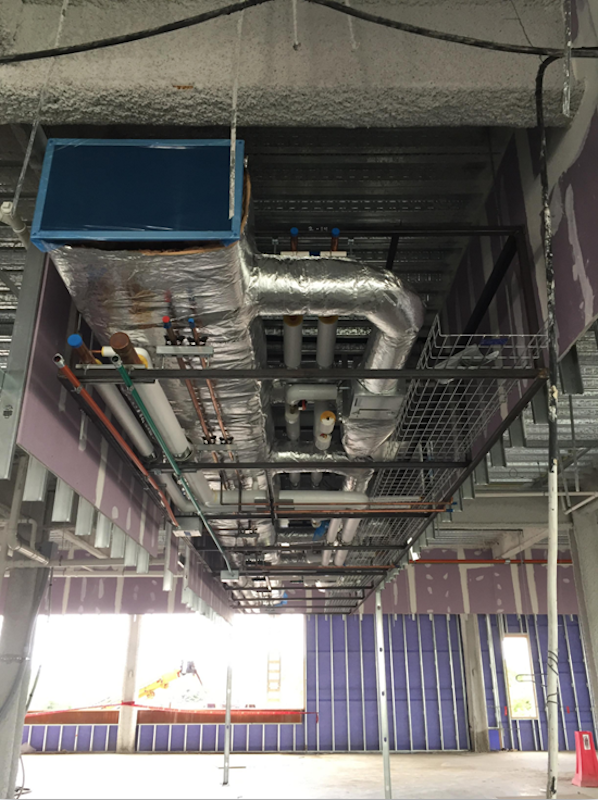Trade partners are still the odd men out during the early stages of many projects, which can make conflicts, change orders, and delays during construction more likely.
To avoid potential snafus on its new Ambulatory Health Center in Greenfield, Wis., Advocate Aurora Health and the real estate developer Cobalt Partners formed an integrated project team with the general contractor CG Schmidt, the national design firm HGA Architects and Engineers, the mechanical contractor J.F. Ahern, and the commercial electrician Staff Electric, the latter two under a Trade Management Partners (TMP) agreement.
“Advocate Aurora Health is leading the industry in integrated project delivery,” says Cory Powers, CPD, Principal and Project Manager for HGA’s energy and infrastructure group.
TMP exemplifies collaboration. Through this arrangement, skilled contractors and supplies can engage early in the project and its design process, which helps reduce redundancies, address challenges that relate to cost and constructability, and come up with more efficient solutions.
The client’s key goal for this five-story 146,200-sf project, located in the 40-acre 84South mixed-use development, was speed to market so it could start seeing patients as soon as possible. That objective led the team to focus on using Lean Construction Methods to accelerate the project’s schedule.
PUSHING THE ENVELOPE ON PREFAB

Two-fifths of the work within 80 MEP racks were prefabricated.
To this end, the project pushed the limits of prefabrication through the use of 80 multi-trade prefab MEP racks that included long sections of duct work in the corridors.
Forty percent of the above-ceiling MEP work was prefabricated off-site. The construction was completed in 18 months, which gave the community local access to healthcare one month earlier compared to a traditional delivery method. Zero percent rework was achieved versus 15% rework in traditional delivery methods. And there were no injuries building and installing the MEP racks.
The team members worked in tandem from a single 3D BIM model, eliminating miscommunication and the need for re-drawings. And to reduce the risk of design errors, the team relied on state-of-the-art fabrication software, with each component barcoded and shipped to the jobsite along with an installation plan.
Using their mobile devices, workers scanned the barcodes to verify the location for each installation. Once on site and verified, the prefabricated racks were lifted to each floor to be connected and attached, a task completed within an hour of each delivery.
Powers of HGA says that prefabrication emerged as a solution during the team’s early design discussions. And the building’s systems “were laid out to be modular.” Powers adds that prefab is playing an even more prominent role in the design and construction of Advocate Aurora Health’s next two hospitals that will include bathrooms and exam rooms assembled off site.
The completed Ambulatory Health Center, which opened August 5, is valued at $55.5 million. The building is the central location for Advocate Aurora Children’s Health services that include pediatric cardiology, urology, allergy, dermatology, ENT, neuropsychology, and radiology. It has eight surgical suites, two pain management procedure rooms, four GI suites and two outpatient interventional radiology suites that are the first of their kind in Wisconsin.
With the Health Center’s recent opening, Advocate Aurora Children’s Health can offer more comprehensive pediatric services to the area. The facility also houses Advocate Aurora’s Sports Health services, along with a pediatric sports health gym and classroom space. This space brings increased availability for outpatient orthopedic surgery to patients.
The Health Center is home to midwifery services with a variety of women’s health services provided, ranging from general health education to family planning and obstetric care. Its outpatient center co-locates orthopedic exam, office, and imaging conveniently at the retail-inspired main entry, with surgical, recovery, and pain management services on floors above.
IPD ‘THE PATH FORWARD’
“This 84South facility is actually one of the very largest outpatient ambulatory sites in all of our Wisconsin and Illinois footprint, and it will enable us to open up access for the people of the broader Greenfield community,” said Advocate Aurora Health's COO Bill Santulli, in an interview with the Milwaukee Business Journal.
When asked why integrated project delivery isn’t more common, Powers says that each AEC firm and owner is at different stages of its Lean journey. “You can’t fake experience in an IPD.” Too many firms and owners “are stuck in delivery methods that are based on fear” that they wouldn’t get the same value from an IPD contract.
“But once you go through one of these, there’s nothing else like them,” says Powers. “We can go pretty fast on our own. But it’s so much faster when you don’t have to explain everything in the field. The team comes out of the gate drumming the same beat when you’ve worked out the details months before the first dirt is broken.”
Mark Lillesand, a Vice President with CG Schmidt, thinks that integrated project design will become more prevalent as more owners become familiar with its benefits, which include “furthering our relationships with subcontractors.”
Lillesand says his firm now “prefabricates everything we can” especially now when the coronavirus has raised the stakes for jobsite safety. He adds that on other projects, CG Schmidt has included subs for drywall, steel construction, and enclosures into the early design discussions. “This is the path forward for us.”
Related Stories
| Aug 11, 2010
Special Recognition: Triple Bridge Gateway, Port Authority Bus Terminal New York, N.Y.
Judges saw the Triple Bridge Gateway in Midtown Manhattan as more art installation than building project, but they were impressed at how the illuminated ramps and bridges—14 years in the making—turned an ugly intersection into something beautiful. The three bridges span 9th Avenue at the juncture where vehicles emerge from the Lincoln Tunnel heading to the Port Authority of New Yor...
| Aug 11, 2010
World's tallest all-wood residential structure opens in London
At nine stories, the Stadthaus apartment complex in East London is the world’s tallest residential structure constructed entirely in timber and one of the tallest all-wood buildings on the planet. The tower’s structural system consists of cross-laminated timber (CLT) panels pieced together to form load-bearing walls and floors. Even the elevator and stair shafts are constructed of prefabricated CLT.
| Aug 11, 2010
Setting the Green Standard For Community Colleges
“Ohlone College Newark Campus Is the Greenest College in the World!” That bold statement was the official tagline of the festivities surrounding the August 2008 grand opening of Ohlone College's LEED Platinum Newark (Calif.) Center for Health Sciences and Technology. The 130,000-sf, $58 million community college facility stacks up against some of the greenest college buildings in th...
| Aug 11, 2010
School Project Offers Lessons in Construction Realities
Imagine this scenario: You're planning a $32.9 million project involving 112,000 sf of new construction and renovation work, and your job site is an active 32-acre junior-K-to-12 school campus bordered by well-heeled neighbors who are extremely concerned about construction noise and traffic. Add to that the fact that within 30 days of groundbreaking, the general contractor gets canned.
| Aug 11, 2010
CityCenter Takes Experience Design To New Heights
It's early June, in Las Vegas, which means it's very hot, and I am coming to the end of a hardhat tour of the $9.2 billion CityCenter development, a tour that began in the air-conditioned comfort of the project's immense sales center just off the famed Las Vegas Strip and ended on a rooftop overlooking the largest privately funded development in the U.
| Aug 11, 2010
University of Arizona College of Medicine
The hope was that a complete restoration and modernization would bring life back to three neoclassic beauties that formerly served as Phoenix Union High School—but time had not treated them kindly. Built in 1911, one year before Arizona became the country's 48th state, the historic high school buildings endured nearly a century of wear and tear and suffered major water damage and years of...
| Aug 11, 2010
Top of the rock—Observation deck at Rockefeller Center
Opened in 1933, the observation deck at Rockefeller Center was designed to evoke the elegant promenades found on the period's luxury transatlantic liners—only with views of the city's skyline instead of the ocean. In 1986 this cultural landmark was closed to the public and sat unused for almost two decades.
| Aug 11, 2010
200 Fillmore
Built in 1963, the 32,000-sf 200 Fillmore building in Denver housed office and retail in a drab, outdated, and energy-splurging shell—a “style” made doubly disastrous by 200 Fillmore's function as the backdrop for a popular public plaza and outdoor café called “The Beach.
| Aug 11, 2010
Integrated Project Delivery builds a brave, new BIM world
Three-dimensional information, such as that provided by building information modeling, allows all members of the Building Team to visualize the many components of a project and how they work together. BIM and other 3D tools convey the idea and intent of the designer to the entire Building Team and lay the groundwork for integrated project delivery.
| Aug 11, 2010
High Tech High International used to be a military facility
High Tech High International, reconstructed inside a 1952 Navy metal foundry training facility, incorporates the very latest in teaching technology with a centerpiece classroom known as the UN Theater, which is modeled after the UN chambers in New York. The interior space, which looks more like a hip advertising studio than a public high school, provides informal, flexible seating areas, abunda...







